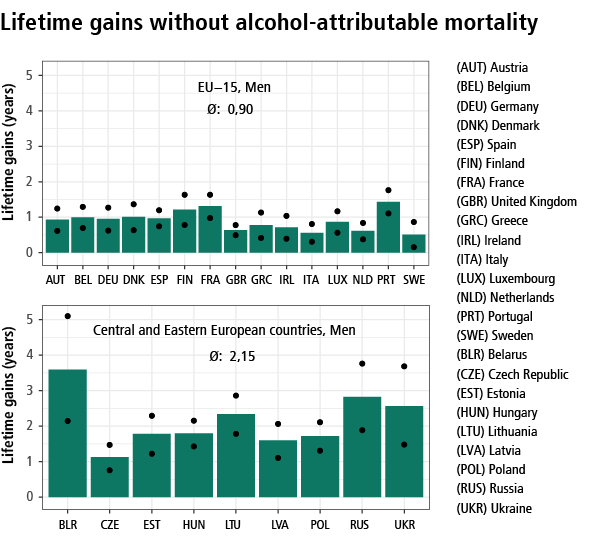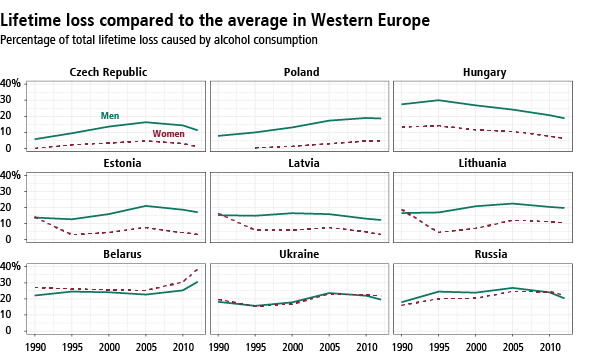May 07, 2018 | News | New Publication
Less alcohol, more life
Alcohol consumption is higher in Europe than in almost any other region of the world. This notably applies to the countries of Eastern Europe, and it is a major cause for the relatively low life expectancy in this region – as shown by a new study. Accordingly, men from Belarus, Russia, and Ukraine are estimated to lose around 2.5 to 3.7 years of lifetime due to excessive alcohol consumption.
(The following text is based on the original paper The contribution of alcohol to the East-West life expectancy gap in Europe from 1990 onward by MPIDR researcher Domantas Jasilionis and has as a German version with minor changes also been published in the issue 1/2018 of the demographic quarterly Demografische Forschung Aus Erster Hand.)
The East-West gap in average life expectancy is markedly wide: In 2012/13, Western European men on average lived around 4 to 15 years longer than their counterparts in Central and Eastern Europe (CEE) countries. Among women, the differences are smaller, at 2.5 to 8 years. A new study now shows that for both sexes an average 20% of these differences can be attributed alone to higher alcohol consumption in Eastern and Central Europe.
Those who often take to the bottle usually die earlier – this is well known. But Domantas Jasilionis from the Max Planck Institute for Demographic Research in Rostock, Sergi Trias Llimós and Fanny Janssen from the University of Groningen, and Anton Kunst from the University of Amsterdam now have shown for the first time ever using various data sets that excessive alcohol consumption strongly contributes to the East-West life expectancy gap in Europe.
The demographers compared data for a total of 15 EU countries and 9 Central and Eastern European countries. For their analysis, they used data on alcohol-attributable mortality from the Global Burden of Disease Study 2013 (GBD) and data for average life expectancy from the Human Mortality Database (HMD).
The researchers thus were able to separate alcohol-attributable mortality from mortality by other causes and to compute the exact number of years a population would gain if there were no early deaths due to alcohol consumption.

Figure 1: If there were no alcohol-attributable mortality in Eastern and Central European countries, men notably would see large lifetime gains in this region. Because alcohol-attributable deaths cannot always be exactly distinguished from death by other causes, uncertainty intervals are provided for each result. Source: GBD, HMD, own calculations
In the Eastern and Central European countries, the average values were 1 year for women and 2.15 years for men (see Figure 1). In Western Europe, men would potentially gain around 11 months and women a good 5 months of lifetime if they refrained from heavy drinking.
The highest gains would be made by Belarusian men, with 3.7 years. Russians and Ukrainians would also live longer – by almost 3 resp. 2 and a half years if they abstained from alcohol more often. Among women, the impact of alcohol consumption on life expectancy is lower, except for Belarusian, Russian, and Ukrainian women.

Figure 2: Life expectancy in Western Europe is much higher than in most Central and Eastern European countries. The graphs for the various countries show the relative percentage contributions of excessive alcohol consumption to the life expectancy gap. Source: GBD, HMD, own calculations
Alcohol contributes to lower life expectancy throughout the CEE region compared to the West, but the exact share varies substantially between the countries (see Figure 2). Next to looking at the latest data available for 2012/13, the demographers also took a look into the past.
Since 1990, the contribution of alcohol to mortality has markedly increased. In 1990 and among men, 17% of the differences to average Western European life expectancy are attributed to excessive alcohol consumption. By 2005, the share increased to over 25%. Among women, it rose from around 15 to 22.5% over the same period. For both sexes, the share then slightly declined to 20% until 2012/13.
These figures are also substantiated by data on alcohol consumption. In Russia, for example, annual levels of pure alcohol consumption increased from 8 to 11 liters between 1990 and 2006. Added to this is the share of unreported consumption, which according to estimates also climbed during this period. Between 2007 and 2010, however, many CEE countries saw a decline in alcohol consumption by 10% and more.
If it were possible to continue this development, further convergence to Western European life-expectancy levels would be achieved, the authors conclude.
Co-author of the scientific study: Domantas Jasilionis
More information
Original article: The contribution of alcohol to the East-West life expectancy gap in Europe from 1990 onward, Trias-Llimós, S., A. E. Kunst, D. Jasilionis and F. Janssen: International Journal of Epidemiology DOI: 10.1093/ije/dyx244